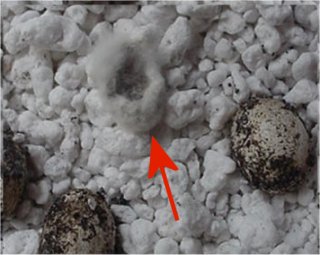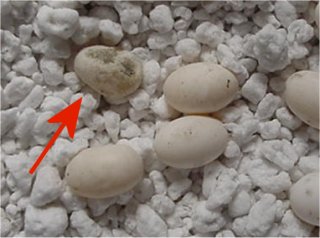Walking around on the floor
My gravid chameleon is walking around on the floor of her cage .
If
this is happening you better have the egg laying area ready for her she is looking for a egg deposit site she is going to
lay her eggs. In an emergency or if you are cramped for room you can use the same sized container as the above pictures.
If your cage is large enough you will have room for this extra addition to your chameleons living area with out a great
degree of trouble when it comes time to lay eggs ! Chameleons will not hesitate to use the flower pot that a living
plant is growing in to deposit the eggs . And most people keep a living plant inside of the cage with their chameleon. A 3
gallon pot is a good egg deposit site also . Or you can use a 33 gallon trash can with 16 to 20 inches of soil for a egg site
.Soil needs to be moist. Your chameleon will dig down and deposit her eggs.
Egg care:
People ask if keeping the eggs in a dark room like a closet is better than allowing light to hit the eggs . I can answer
that question like this . We have kept veiled eggs in both areas. One year we had them close to a southern exposed window
. Lots of light . The slightest bit of an increase in a minimal amount of mold in the side of the box that had the most light
occurred. Nothing to worry about ! But we still keep them out of direct sunlight in a room with normal amounts of light .
The lighting is off during the daytime . Wile using the "mold " word white mold showing on the eggs just after laying
is usually a sign the eggs are infertile black or dark mold is usually a sign to much water used when you mixed your
substrate together .
Good eggs are close to white in color dark eggs usually are also bad . Yellow shinny eggs
are usually bad . Don't know or are not sure about the color of a chameleon egg ? Look at a chicken egg like the ones in your
refrigerator . The color is very similar. Shrinking eggs are another sign of being infertile . But can also be a sign of low
humidity levels in your egg box .
 |
View of dented egg with white mold . Not good ! |
|

|
View of dented egg .Probablynotfertile | Remove dented eggs or not to remove dented eggs?
I will leave a dented egg in the egg box until I see mold and shrinking occur. It actually has to be completely
collapsed before I consider it as infertile and remove it . Even if shrunken I will leave it in the box for the complete
incubation cycle . More than once chameleon eggs thought to be "bad " have hatched. Much to my surprise out walks
a perfectly healthy baby chameleon . Truly a treat !
Mixture of pearlite and water :
I have 16 oz deli cups I fill two of them (32 oz) adding one quarter
cup water shake well to mix water with perlite .I have always used filtered tap water ! I also mist the lids of these boxes
two times per month . You can see a little bit of moisture build up on the side walls of the egg box during the AM because
of a temperature difference . I notice it disappears about every 14 days that's why I mist the lid only twice per month and
it allows more fresh air inside as well .
Incubation temperatures: 68 ntl (night time lows) 74 dth ( day time highs) Fahrenheit
Temperatures relating to faster incubation times for veiled chameleon eggs :
Over the last few
years I have had several people tell me they had good results using higher temperatures to incubate Veiled eggs .85
degrees F . I do not advise using higher temps simply because the 68 - 74 degrees F temps work so good for me. I also notice
no albumin left in the eggs incubated at the lower temperatures . It has been my experience babies born with higher
temps were smaller chameleons at birth . This is just my experience . Another interesting thing is none of the breeders using
higher temperatures are still breeding veiled chameleons. If your eggs get warmer for a few days it's nothing to worry
about anything higher than 85 would be bad for the eggs . Generally cooler is better than warmer . When saying
warmer ! I am speaking to the extreme high temperatures above 85 F and lows in the mid 60's .
Feeding relative to egg production
How many food items is correct.
What kind of feeder insects
to use .
The psychical condition or your chameleon is important to the results of egg laying . Her condition is controlled
by her feeding habits that you are in charge of. It's up you you to feed her enough so she can develop all the eggs in her
body. Allowing her to be in good enough health to deliver them . This is not to tuff to do .
If she
is gravid feed her all she wants to eat 8 3/4 to full grown crickets per feeding (daily) is going to do nicely coating them
with calcium and including vitamin supplements also . You will notice she will eat as many as you place in her cage . She
will over eat if allowed to . It will not hurt her but she will simply pass undigested insect parts in her stool as a result
of over feeding .
You can use 3 oz of tap water and place a stool sample in the water to look at the
size of the particles in the water . All the particulate should be even in size as well as small see any full sized legs of
a cricket and you will be looking at a chameleon who is being over feed. Vary her diet wile gravid if you can.
A large worm from south America pops up into the reptile trade every so often "butter worm" is one name that comes to
mind . These insect larva do not eat anything found here in the USA and as a result might be left in a container for
a few weeks before we get them as a food item They have survived on the same protein that your chameleon wants
from them . Yes! This worm is not a very good food source! Unlike superworms that are! So try not to get the names
mixed up. Remember the scientific name of the superworms (Zophobas morio). | 
